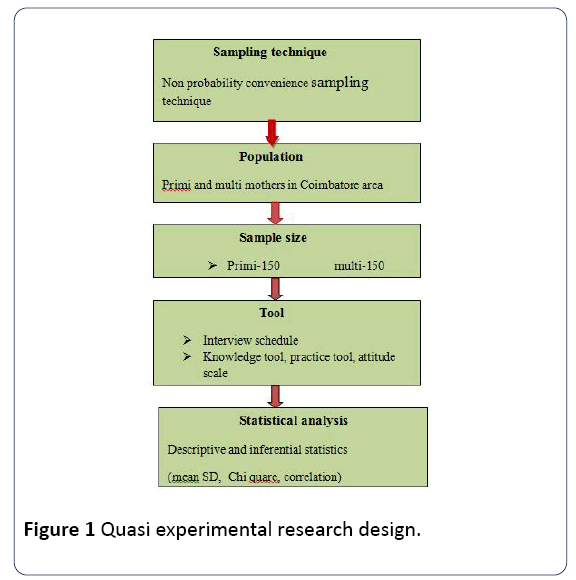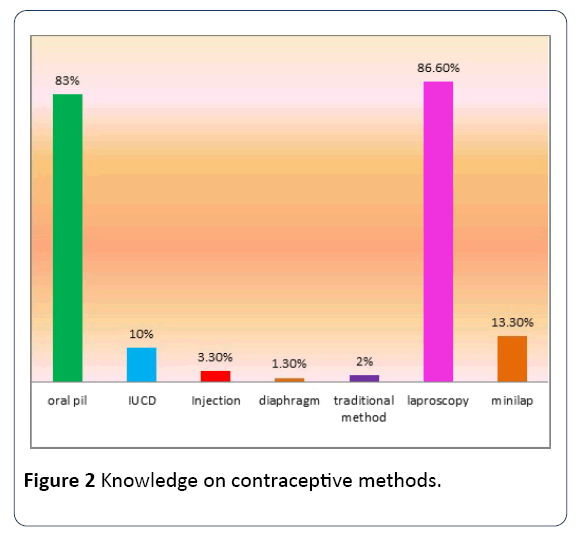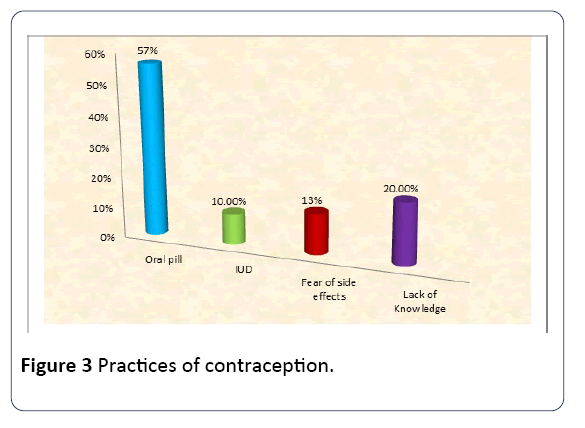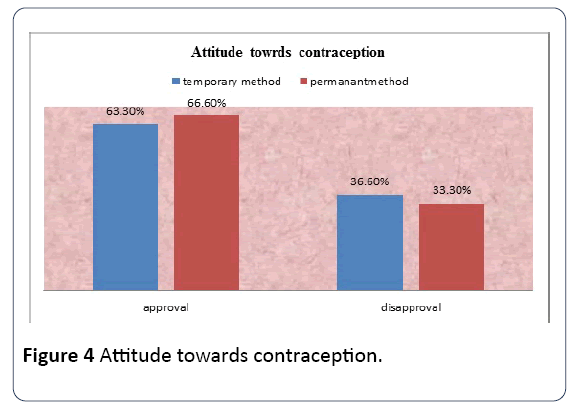Keywords
Contraceptive; Birth rate; Nursing
Introduction
India was the first country in the world to formulate the national family planning programme in the year 1952 with the objective of reducing the birth rate of extent necessary to stabilize the population at a level consistent with requirement of national economy. One of the main objectives of the programme is to space the knowledge of family planning methods and develop among the people an attitude favorable for adoption of contraceptive methods. The progress achieved in this sphere is normally assessed form the result of Knowledge, Attitude and Practice survey. Despite the fact that contraception usage has increased over a period of time, there exist a Knowledge Attitude and Practice-gap. That is a gap between Knowledge Attitude and Practice regarding contraception.
In developing country like India, over population is a major concern. Despite progress resulting from making contraception widely available, there is poor acceptance of contraception. Methods either due to ignorance or fear of complications using them.
Inadequate knowledge attitude and practice about contraception method and incomplete or enormous information about their use or where to procure them are the main reason for not accepting formula planning. Keeping all the facts in view this stand was carried and to assess the Knowledge Attitude and Practice of contraceptive methods among prime and Multi mothers in Coimbatore.
Family planning is defined by WHO as “ a way of thinking and lining that is adapted voluntarily, upon the basis of knowledge, Attitudes and responsible decisions by individuals and couples, in order to promote the health and welfare of family group and this contribute effectively to the social development of a country” [1,2].
Objectives
• To assess the knowledge, attitude and practice of Temporary, permanent contraceptive methods among primi and multi mothers.
• To deliver the Structured Teaching Programme on Temporary and permanent contraceptive methods among primi and multi mothers.
• To evaluate the effectiveness of Structure Teaching Programme on Temporary and permanent contraceptive methods among primi and multi mothers.
• To correlate the relationship between knowledge. Practice and attitude of Temporary contraceptive methods among primi and multi mothers.
• To find out significant association between knowledge, Practice and attitude with selected demographic variables.
Delimination
The study is delimited to
• Mothers who are in selected two areas of Coimbatore- Alandurai and Rathinapuri.
• Mothers who had inadequate knowledge of permanent and temporary contraception among primi and multi mothers in terms of knowledge awareness and utilization.
• Who are in primi and multi mothers during home home visit?
• Sample size is primi mother=150; multi mother=150.
Projected outcome
This study will give a clear understanding of the knowledge attitude and practice of temporary and permanent contraceptive method. The instruction module associated with temporary and permanent contraception methods will be effective improving the knowledge attitude and practice among mothers. The outcome of the study will be helpful to educate the mother regarding temporary and permanent contraceptive methods there by improve the maternal and child health.
Material and Methods
Research Design selected for the present study was quasi experimental one group pre-test and post-test design. In the present study a pre-test was administered by means of questionnaire method depicted as 01, and then structured teaching programme was delivered depicted as X and post-test was conducted by using the same questionnaire depicted as 02 (Table 1).
Table 1 Quasi experimental of pre-test and post-test level of knowledge.
| 1 |
x |
2 |
| Assessing the pre-test level of knowledge attitude and practice of mothers regarding contraceptive methods |
Teaching module |
Assessing the post-test level of knowledge attitude and practice of mothers regarding contraceptive methods |
The investigator had chosen the survey research design which comes under the quasi experimental research design to assess the knowledge, practice and attitude of temporary and permanent contraceptive methods among primi and multi mothers in Coimbatore area (Figure 1).

Figure 1: Quasi experimental research design.
Setting of the study
The study was conducted while home visit among primi and Multi mother in selected areas at Coimbatore.
Variables
• Independent variables - structured teaching programme on contraceptive methods.
• The dependent variable - knowledge, attitude and practice of mothers regarding contraceptive methods.
• The influence variables - demographic variables (Table 2).
Table 2 Schematic representation of relationship of variables.
| Influence variable |
Sample No, Age, Educational status, Type of family, Occupation station, Family income, Source of information regarding, Contraceptive methods |
| Dependent variables |
Knowledge attitude and Practice regarding contraceptive method |
| Independent variables |
structured teaching programme on contraceptive methods |
Population
The population of the study includes the primi and multi mother.
Sample size
The Sample size included for the study consists of primi=150, multi=150 mother.
Sampling technique
Non- Probability convenient sampling technique will use to select the sample.
Criteria for selection of the sample
Inclusive criteria
• Mother between age 21-40 years.
• Mother who were residing in Coimbatore area.
• Both primi and multi mother.
• Who were willing to participate.
• Who know to speak Tamil and English freely.
• Who were attending educational programe in home?
Exclusion criteria
• Above the age 40 years.
• Who are not willing to participate.
• Any reproductive problems.
Description of tools
The researchers have developed an interview schedule after reviewing the literature and considering the opinion of medical and Nursing subject experts, to measure the knowledge, practice and Attitude regarding on Temporary and permanent contraceptive Methods.
Part A: Distribution of demographic variables: It includes the sample number, age of the samples, educational status, type of family, occupational status of the Mother, family income, and sources of information regarding temporary contraceptive methods.
Part B: Questions regarding knowledge: It consist of questions related to assessment of the knowledge of Primi and multi Mothers regarding temporary and permanent contraceptive Methods.
Interpretation of the questionnaire
Each question had one correct answer and was given score of one mark, for wrong answer a score of Zero was given.
Part C: Questions Regarding Practice: It consists of questions related to assessment of practice of Primi and multi Mother regarding temporary and permanent contraceptive methods.
Interpretation of the questionnaire
One mark, was given for ‘yes’ answer and zero mark for ‘No’ answer.
Part D: Question regarding attitude: It consists of questions related to assessment of attitude of Primi and multi mother regarding temporary and permanent contraceptive methods.
Content validity
The interview Schedule was given to five experts specialized in obstetrics and Gynecology the researcher met the expert for clarifications in various aspects of the research tool. Some Modifications were made according to the expert suggestions [3-5].
Reliability on the instrument
The main objective of the pilot study was to ensure the reliability of the interview Schedule, was found out by spearman brown split-half technique. The reliability of the tool was satisfactory (Table 3).
Table 3 Showing reliability for temporary contraceptive method interview schedule.
| Item |
Split half reliability |
| Temporary Contraceptive method interview Schedule |
0.9 |
| Permanent Contraceptive method interview Schedule |
0.9 |
Pilot study
The Pilot study was conducted to test the reliability content validity and practicability of the tool. Pilot study was conducted for 7 days. The area selected was at Kovilpalayam and Kurumbapaayam area in Coimbatore. 15 primi mothers and 15 multi mothers were selected during the pilot study. The knowledge, practice and attitude regarding temporary and permanent contraceptives methods were assessed with the prepared questionnaires. The education module was prepared to enhance the knowledge, practice and attitude regarding temporary and permanent contraceptives methods. Health education was given with the help of flashcards, booklet, pamphlets and samples of contraceptives were distributed. The results of the pilot study showed that there was positive correlation between knowledge, practice and attitude with demographic variables.
Procedure for data collection
Prior permission was obtained from the mothers by submitting an application giving assurance to abide by the rules and regulations. The study was done for a period of 4 weeks. The investigator identified the Mother that fulfilled the inclusion criteria. The mothers were explained about the purpose of the study in a manner and informed consent was taken. Necessary precautions were taken to provide privacy and confidentiality.
In pre-test the knowledge and practice of mothers regarding temporary and permanent contraceptive methods was assessed following pre-test by using the same questionnaire. On the same day structured teaching module was educated by demonstration flashcards and pamphlets. Post test was conducted on the 5th day by using the same questionnaire to find out the effectiveness.
Plan for data analysis
• Data was planned to be analyzed by using descriptive and inferential statistics
• Descriptive statistics were used to analyze the frequency, percentage, mean standard deviation of the following variables
• Demographic variable of primi mother
• Knowledge regarding temporary and permanent contraceptive methods
• Practice regarding temporary and permanent contraceptive methods
• Attitude regarding temporary and permanent contraceptive methods
Inferential statistics were used to determine the relationship and comparison to identify the difference. t-test was used to compare the knowledge, practice and attitude regarding temporary and permanent contraceptive method. Chi-square t-test was computed to find out the association between knowledge, practice and attitude with selected demographic variables.
Demographic characteristics of the study population
The knowledge about one or more methods of contraception, particularly modern contraceptive methods was 95.0%. The knowledge about traditional methods of contraception was 72.0% and 46.4% devices (Table 4).
Table 4 Knowledge on contraceptive methods.
| Contraceptive methods |
Number : 150 |
Percentage |
| Temporary contraceptive methods PRIMI=150 |
| Oral pill |
125 |
83% |
| IUCD |
15 |
10 |
| Injection |
5 |
3.30% |
| Female condom |
- |
|
| Diaphragm |
2 |
1.30% |
| Emergency contraception Norplant |
- |
|
| Traditional methods |
3 |
2% |
| PERMANENT CONTRACEPTIVE METHODS: multi:150 |
| Laproscopy |
130 |
86.60% |
| Mini lap |
20 |
13.30% |
Most common source of knowledge for mother in general was the usage of oral pill (83.0%), IUCD (22.56%). Injection (7.5% and 4.5% as traditional methods respectively of 150 interviewed couples (Figure 2). Completion of family was found to be the most common reason for using contraception (81.1%) and fertility related reasons (45.1%) followed by husband’s opposition (28.4%) were the common reasons for not using contraception (Table 5 and Figure 3).

Figure 2: Knowledge on contraceptive methods.

Figure 3: Practices of contraception.
Table 5 Practices of contraception.
| Contraceptive methods |
Number: 150 |
Percentage |
| Temporary methods |
| Oral pill |
85 |
56.60% |
| IUD |
15 |
10% |
| Female condom |
- |
- |
| Spacing |
- |
- |
| Fear of side effect |
20 |
13.30% |
| Lack of knowledge |
30 |
20% |
| Permanent methods |
| Laproscopy |
130 |
86.60% |
| Minilap |
20 |
13.30% |
Attitude of temporary contraceptive methods approval rate was 95 (63.3%), disapproval rate was 55 (36.6) and permanent contraceptive methods approval rate was 100 (66.6%), disapproval rate was 50 (33.3%) (Table 6 and Figure 4).

Figure 4: Attitude towards contraception.
Table 6 Attitude towards contraception.
| Attitude of contraception |
Temporary methods Total: 150 |
Permanent methods Total: 150 |
| Approval |
95 (63.3%) |
100 (66.6%) |
| Disapproval |
55 (36.6%) |
50 ( 33.3%) |
Discussion
The present study aimed to assess the knowledge, attitude and practice of family planning methods to enhance the contraceptive practice in the rural community in future. Results showed that the overall knowledge about any method of Temporary contraception was 98% and permanent methods were 63.3%. The findings are similar to practice and attitude of study. Reveals good knowledge and favorable attitude of rural couples towards contraception [6].
Contraceptive knowledge and practice was influenced by exposure to family planning messages and partner opposition. Women education and counseling can play an important role to adopt family planning methods. The mothers should be given information about contraceptives at every visit to the health services to motivate them [7-10].
Conclusion
The most important factor is regular availability of contraceptives and adequate health care services at the peripheral level. Electronic media, health personnel and government’s organizations can play a positive role to provide knowledge and overcome the knowledge, practice and attitude of Temporary and permanen contraceptive methods.
22843
References
- https://www.who.int/news-room/fact-sheets/detail/family-planning-contraception
- https://www.open.edu/openlearncreate/mod/oucontent/view.php?id=144&printable=1
- Pankaj D, Purvi P (2005) Current practice in obstetrics and gynecology. Explore Health Sci pp: 1-30.
- Wat J (2001) Gynaecology Illustrated. (5th edn.). David McKay Hart, Jane Norman (Eds.), Churchill Livingstone, London. pp: 1-528.
- Dutta DC (1998) DC Dutta's textbook of gynecology: including contraception. (7th edn.). Hiralal Konar (Eds.), New Central Book Agency, New Delhi. pp: 1-686.
- International Planned Parenthood Federation IPPF. International Medical Advisory Panel IMAP (1993) IMAP statement on voluntary surgical contraception. IPPF Med Bull 27: 1-2.
- Shukla M, Fonseca M, Deshmukh P (2017) A study on contraceptive knowledge, attitudes and practices among women in the reproductive age group. Int J Reprod Contracept Obstet Gynecol 6: 3560-3563.
- Kushwah B, Agrawal S (2015) Knowledge, attitude and practice of contraception: a study from rural tertiary health care centre. Int J Reprod Contracept Obstet Gynecol 4: 329-333.
- Jayanthi TP, Abishek B (2017) Birth Spacing: Women’s knowledge, methods adopted and barriers -a study from urban Tamil Nadu. National J Res Community Med 6: 187-194.









